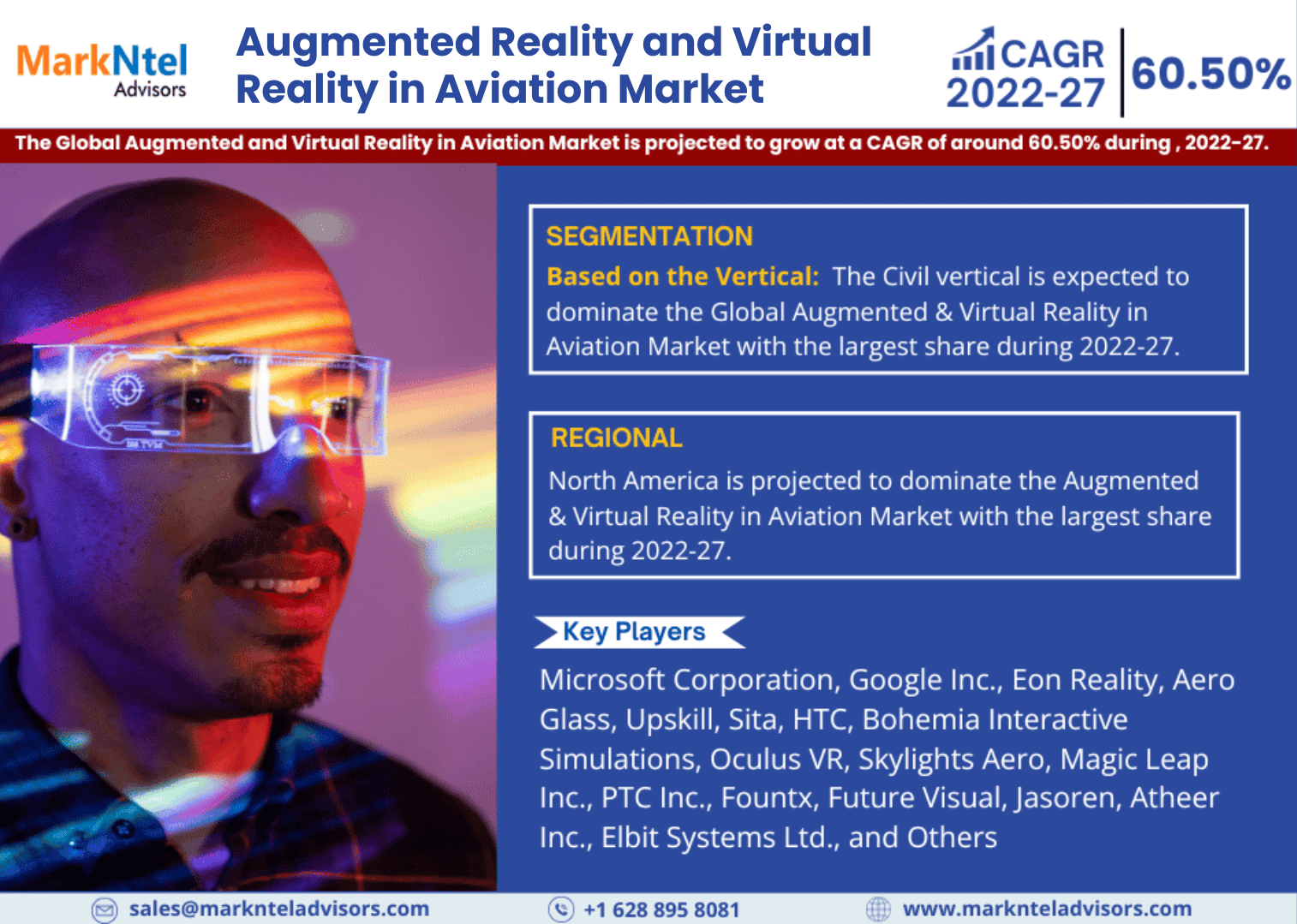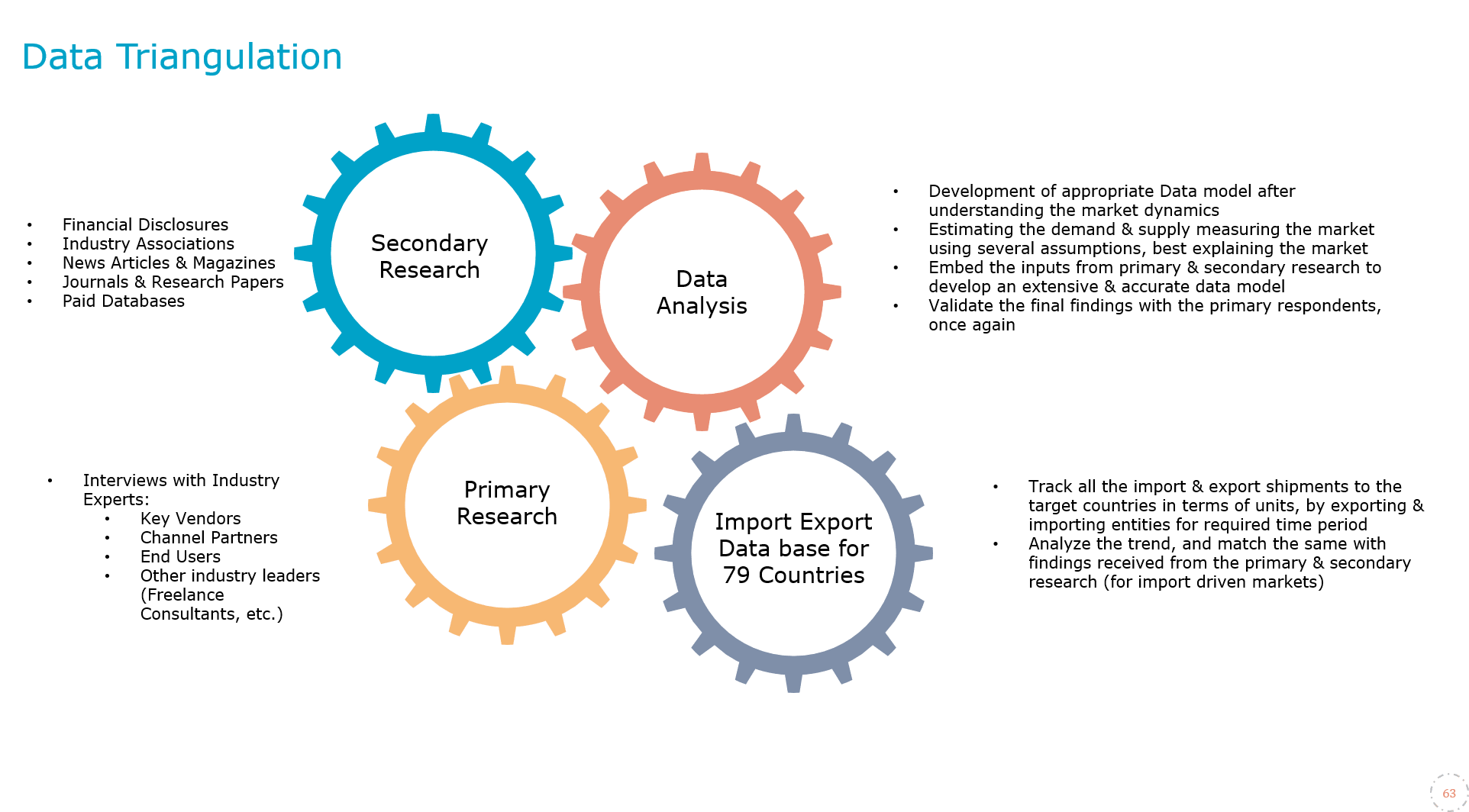
Global Augmented Reality and Virtual Reality in Aviation Market Research Report: Forecast (2022-27)
Augmented Reality and Virtual Reality in Aviation Market - By Product (Head-Mounted Displays, Head-Up Displays, Handheld Devices, Gesture-Tracking Devices), By Application (On Boar...d [In-Flight Entertainment, Flight Deck Systems], Off-Board), By Technology (Augmented Reality [Maker Based, Non-Marker-Based], Virtual Reality [Immersive, Non-Immersive]), By Component (Hardware [Sensors, Processors & Controllers, Displays, Cameras, Others], Software [AR Remote Collaboration, 3D Modeling, Workflow Optimization, Others]), By Function (Pilots Training, Crew & Ground Support Staff Training, Engineers Training, Airlines Operation, Airport Operation, Others), By Vertical (Civil, Military) and Others Read more
- Aerospace & Defense
- Mar 2021
- Pages 240
- Report Format: PDF, Excel, PPT
Market Overview
The aviation industry is one of the fastest-growing & prominent sectors that procure the latest technologies, aircraft, and new models & versions, principally to better the industry and enhance the passenger experience in every possible way.
Several researchers & developers are working on integrating augmented & virtual reality technological solutions in the aviation industry to improve operational efficiency & offer greater productivity. As a result, both civil & military aviation verticals are increasingly inclining toward exhibiting these technologies and gaining an edge in the industry.
Market Insights
The Global Augmented and Virtual Reality in Aviation Market is projected to grow at a CAGR of around 60.50% during the forecast period, i.e., 2022-27. The growth of the market is driven by the surging air traffic worldwide, i.e., propelling airlines to expand their aircraft fleet, coupled with the mounting need to bring operational efficiency, cost-effectiveness, zero or minimal human errors, & enhance the passenger experience across the aviation industry.
| Report Coverage | Details |
|---|---|
| Study Period | Historical Data: 2017-20 |
| Base Year: 2021 | |
| Forecast Period: 2022-27 | |
| CAGR(2022-27) | 60.50% |
| Regions Covered | North America: The US, Canada, Mexico |
| Europe: Germany, The UK, France, Russia, Rest of Europe | |
| Asia-Pacific: China, Japan, India, Australia, Rest of Asia Pacific | |
| South America: Brazil, Argentina, Rest of South America | |
| Middle East & Africa: Israel, GCC, South Africa, Rest of The Middle East & Africa | |
| Key Companies Profiled |
Microsoft Corporation, Google Inc., Eon Reality, Aero Glass, Upskill, Sita, HTC, Bohemia Interactive Simulations, Oculus VR, Skylights Aero, Magic Leap Inc., PTC Inc., Fountx, Future Visual, Jasoren, Atheer Inc., Elbit Systems Ltd., HoneyWell International Inc., IBM |
| Unit Denominations | USD Million/Billion |
Besides, massive support from governments of different countries worldwide and the active participation of prominent players in developing & integrating augmented & virtual reality solutions in the aviation sector are also driving the global market.
Moreover, the soaring application of these technological solutions for training & practices for pilots & crew for a better experience and closer view of situations than conventional methods is another prominent aspect infusing the demand for augmented & virtual reality solutions across the aviation industry.
Furthermore, the mounting government focus on strengthening the civil & military aviation capabilities with the latest technologies, upgrades, & versions, especially across developed & developing countries, shall further boost the global market in the years to come.
Impact of Covid-19 on the Global Augmented and Virtual Reality in Aviation Market
The advent of Covid-19 in 2020 had a decelerating impact on most industries worldwide, where aviation & its related sectors observed a catastrophe. The Global Augmented & Virtual Reality in Aviation Market was no exception and witnessed several challenges associated with the development & integration of these technologies into the aviation industry.
It was principally due to the imposition of stringent movement restrictions & lockdowns by governments of different countries worldwide to curb the spread of this dreadful disease. Since most countries restrained traveling amidst the crisis, air traffic displayed a severe downfall and reduced the demand for aircraft & the integration of new technologies.
Moreover, with the paradigm shift toward work-from-home, several research & development activities for augmented & virtual reality in the aviation sector were put on a temporary hold, which further caused substantial financial losses for the leading market players.
However, with the reducing number of Covid-19 cases, restrictions were uplifted, and business operations recommenced, which, in turn, generated growth opportunities for the leading players to bring new features & upgrades in their product offerings to the aviation industry. The same trend is likely in the coming years, which would drive lucrative opportunities for the global market.

Market Segmentation
Based on the Vertical:
- Civil
- Military
Amongst these two, the Civil vertical is expected to dominate the Global Augmented & Virtual Reality in Aviation Market with the largest share during 2022-27. It owes principally to the growing air travel worldwide due to improved economy & changing living standards of people. It, in turn, is leading to an increased aircraft procurement for civil applications and encouraging the leading market players to provide aircraft integrated with advanced technologies like augmented & virtual reality solutions.
Besides, the mounting demand for bringing cost-effectiveness & operational efficiency to airlines is another aspect behind the burgeoning demand for augmented & virtual reality solutions in the civil aviation sector and driving the market through 2027. Moreover, these solutions are also gaining swift momentum for training & practice sessions to offer a closer look at uncertain & critical situations that the pilot & crew might face. Hence, these aspects project a significant growth prospect for the global market around the civil aviation vertical in the coming years.
Regional Landscape
Geographically, the Global Augmented & Virtual Reality in Aviation Market expands across:
- North America
- South America
- Europe
- Middle East & Africa
- Asia-Pacific
Amongst all regions globally, North America is projected to dominate the Augmented & Virtual Reality in Aviation Market with the largest share during 2022-27. It owes principally to prominent market players extensively present in the region & actively participating in developing augmented & virtual reality solutions and integrating them into the aviation sector.
North America is amongst the early adopters of advanced technologies and has a vast aircraft fleet. The increasing number of collaborations, partnerships, & acquisitions among the regional market leaders and the growing inclination of major countries across the region toward strengthening their aviation sectors are other crucial aspects projected to drive the regional market in the coming years.
On the other hand, Asia-Pacific is anticipated to display the fastest market growth over the forecast years, principally due to the rapidly expanding trade relations among different countries across the region, export promotions, maturing open sky agreements, and developing logistics.
It, in turn, is generating growth opportunities for the leading players in the market to scale their offerings in the aviation industry across Asia-Pacific & drive the regional market through 2027. Besides, the escalating need for different countries in the region to utilize augmented & virtual reality solutions for strengthening defense aviation is another prominent aspect projected to propel the market growth across Asia-Pacific in the years to come.
Key Questions Answered in the Market Research Report:
- What are the overall statistics or estimates (Overview, Size- By Value, Forecast Numbers, Segmentation, Shares) of the Global Augmented & Virtual Reality in Aviation Market?
- What are the region-wise industry size, growth drivers, and challenges?
- What are the key innovations, opportunities, current & future trends, and regulations in the Global Augmented & Virtual Reality in Aviation Market?
- Who are the key competitors, their key strengths & weaknesses, and how do they perform in the Global Augmented & Virtual Reality in Aviation Market based on the competitive benchmarking matrix?
- What are the key results derived from surveys conducted during the Global Augmented & Virtual Reality in Aviation Market study?
Frequently Asked Questions
- Market Segmentation
- Introduction
- Product Definition
- Research Process
- Assumptions
- Executive Summary
- Global Augmented Reality and Virtual Reality in Aviation Market Policies, Regulations, and Product Standards
- Global Augmented Reality and Virtual Reality in Aviation Market Supply Chain Analysis
- Global Augmented Reality and Virtual Reality in Aviation Market Trends & Developments
- Global Augmented Reality and Virtual Reality in Aviation Market Dynamics
- Growth Drivers
- Challenges
- Global Augmented Reality and Virtual Reality in Aviation Market Hotspot & Opportunities
- Global Augmented Reality and Virtual Reality in Aviation Market Outlook, 2020-2030F
- Market Size & Outlook
- By Revenues (USD Million)
- Market Share & Outlook
- By Product
- Head-Mounted Displays- Market Size & Forecast 2020-2030, USD Million
- Head-Up Displays- Market Size & Forecast 2020-2030, USD Million
- Handheld Devices- Market Size & Forecast 2020-2030, USD Million
- Gesture-Tracking Devices- Market Size & Forecast 2020-2030, USD Million
- By Application
- On Board- Market Size & Forecast 2020-2030, USD Million
- In-Flight Entertainment- Market Size & Forecast 2020-2030, USD Million
- Flight Deck Systems- Market Size & Forecast 2020-2030, USD Million
- Off-Board- Market Size & Forecast 2020-2030, USD Million
- On Board- Market Size & Forecast 2020-2030, USD Million
- By Technology
- Augmented Reality- Market Size & Forecast 2020-2030, USD Million
- Maker Based- Market Size & Forecast 2020-2030, USD Million
- Low Memory and Processing Capacity Requirements- Market Size & Forecast 2020-2030, USD Million
- Passive Markers- Market Size & Forecast 2020-2030, USD Million
- Active Markers- Market Size & Forecast 2020-2030, USD Million
- Non-Marker-Based- Market Size & Forecast 2020-2030, USD Million
- Real-Time and More Interactive Augmentation- Market Size & Forecast 2020-2030, USD Million
- Model-Based Tracking- Market Size & Forecast 2020-2030, USD Million
- Image-Based Tracking- Market Size & Forecast 2020-2030, USD Million
- Maker Based- Market Size & Forecast 2020-2030, USD Million
- Virtual Reality- Market Size & Forecast 2020-2030, USD Million
- Immersive- Market Size & Forecast 2020-2030, USD Million
- Enhanced User Experience- Market Size & Forecast 2020-2030, USD Million
- Semi-Immersive- Market Size & Forecast 2020-2030, USD Million
- Fully Immersive- Market Size & Forecast 2020-2030, USD Million
- Non-Immersive- Market Size & Forecast 2020-2030, USD Million
- Immersive- Market Size & Forecast 2020-2030, USD Million
- Augmented Reality- Market Size & Forecast 2020-2030, USD Million
- By Component
- Hardware- Market Size & Forecast 2020-2030, USD Million
- Sensors- Market Size & Forecast 2020-2030, USD Million
- Processors & Controllers- Market Size & Forecast 2020-2030, USD Million
- Displays- Market Size & Forecast 2020-2030, USD Million
- Cameras- Market Size & Forecast 2020-2030, USD Million
- Others (Position Trackers, Integrated Circuits, etc.)- Market Size & Forecast 2020-2030, USD Million
- Software- Market Size & Forecast 2020-2030, USD Million
- AR Remote Collaboration- Market Size & Forecast 2020-2030, USD Million
- 3D Modeling- Market Size & Forecast 2020-2030, USD Million
- Workflow Optimization- Market Size & Forecast 2020-2030, USD Million
- Others (Visualization, Navigation etc.)- Market Size & Forecast 2020-2030, USD Million
- Hardware- Market Size & Forecast 2020-2030, USD Million
- By Function
- Pilots Training- Market Size & Forecast 2020-2030, USD Million
- Crew & Ground Support Staff Training- Market Size & Forecast 2020-2030, USD Million
- Engineers Training- Market Size & Forecast 2020-2030, USD Million
- Airlines Operation- Market Size & Forecast 2020-2030, USD Million
- Airport Operation- Market Size & Forecast 2020-2030, USD Million
- Others (Aircraft Operation, Maintenance Repair and Overhaul Operation etc.)- Market Size & Forecast 2020-2030, USD Million
- By Vertical
- Civil- Market Size & Forecast 2020-2030, USD Million
- Military- Market Size & Forecast 2020-2030, USD Million
- By Region
- North America
- South America
- Europe
- Middle East and Africa
- Asia-Pacific
- By Company
- Company Revenue Shares
- Competitor Characteristics
- By Product
- Market Size & Outlook
- North America Augmented Reality and Virtual Reality in Aviation Market Outlook, 2020-2030F
- Market Size & Outlook
- By Revenues (USD Million)
- Market Share & Outlook
- By Product- Market Size & Forecast 2020-2030, USD Million
- By Application- Market Size & Forecast 2020-2030, USD Million
- By Technology- Market Size & Forecast 2020-2030, USD Million
- By Component- Market Size & Forecast 2020-2030, USD Million
- By Function- Market Size & Forecast 2020-2030, USD Million
- By Vertical- Market Size & Forecast 2020-2030, USD Million
- By Country
- The US
- Canada
- The US Augmented Reality and Virtual Reality in Aviation Market Outlook, 2020-2030F
- Market Size & Outlook
- By Revenues (USD Million)
- Market Share & Outlook
- By Product- Market Size & Forecast 2020-2030, USD Million
- By Technology- Market Size & Forecast 2020-2030, USD Million
- By Component- Market Size & Forecast 2020-2030, USD Million
- Market Size & Outlook
- Canada Augmented Reality and Virtual Reality in Aviation Market Outlook, 2020-2030F
- Market Size & Outlook
- By Revenues (USD Million)
- Market Share & Outlook
- By Product- Market Size & Forecast 2020-2030, USD Million
- By Technology- Market Size & Forecast 2020-2030, USD Million
- By Component- Market Size & Forecast 2020-2030, USD Million
- Market Size & Outlook
- Market Size & Outlook
- South America Augmented Reality and Virtual Reality in Aviation Market Outlook, 2020-2030F
- Market Size & Outlook
- By Revenues (USD Million)
- Market Share & Outlook
- By Product- Market Size & Forecast 2020-2030, USD Million
- By Application- Market Size & Forecast 2020-2030, USD Million
- By Technology- Market Size & Forecast 2020-2030, USD Million
- By Component- Market Size & Forecast 2020-2030, USD Million
- By Function- Market Size & Forecast 2020-2030, USD Million
- By Vertical- Market Size & Forecast 2020-2030, USD Million
- By Country
- Brazil
- Argentina
- Rest of South America
- Brazil Augmented Reality and Virtual Reality in Aviation Market Outlook, 2020-2030F
- Market Size & Outlook
- By Revenues (USD Million)
- Market Share & Outlook
- By Product- Market Size & Forecast 2020-2030, USD Million
- By Technology- Market Size & Forecast 2020-2030, USD Million
- By Component- Market Size & Forecast 2020-2030, USD Million
- Market Size & Outlook
- Argentina Augmented Reality and Virtual Reality in Aviation Market Outlook, 2020-2030F
- Market Size & Outlook
- By Revenues (USD Million)
- Market Share & Outlook
- By Product- Market Size & Forecast 2020-2030, USD Million
- By Technology- Market Size & Forecast 2020-2030, USD Million
- By Component- Market Size & Forecast 2020-2030, USD Million
- Market Size & Outlook
- Market Size & Outlook
- Europe Augmented Reality and Virtual Reality in Aviation Market Outlook, 2020-2030F
- Market Size & Outlook
- By Revenues (USD Million)
- Market Share & Outlook
- By Product- Market Size & Forecast 2020-2030, USD Million
- By Application- Market Size & Forecast 2020-2030, USD Million
- By Technology- Market Size & Forecast 2020-2030, USD Million
- By Component- Market Size & Forecast 2020-2030, USD Million
- By Function- Market Size & Forecast 2020-2030, USD Million
- By Vertical- Market Size & Forecast 2020-2030, USD Million
- By Country
- The UK
- Germany
- France
- Italy
- Spain
- Rest of Europe
- The UK Augmented Reality and Virtual Reality in Aviation Market Outlook, 2020-2030F
- Market Size & Outlook
- By Revenues (USD Million)
- Market Share & Outlook
- By Product- Market Size & Forecast 2020-2030, USD Million
- By Technology- Market Size & Forecast 2020-2030, USD Million
- By Component- Market Size & Forecast 2020-2030, USD Million
- Market Size & Outlook
- Germany Augmented Reality and Virtual Reality in Aviation Market Outlook, 2020-2030F
- Market Size & Outlook
- By Revenues (USD Million)
- Market Share & Outlook
- By Product- Market Size & Forecast 2020-2030, USD Million
- By Technology- Market Size & Forecast 2020-2030, USD Million
- By Component- Market Size & Forecast 2020-2030, USD Million
- Market Size & Outlook
- France Augmented Reality and Virtual Reality in Aviation Market Outlook, 2020-2030F
- Market Size & Outlook
- By Revenues (USD Million)
- Market Share & Outlook
- By Product- Market Size & Forecast 2020-2030, USD Million
- By Technology- Market Size & Forecast 2020-2030, USD Million
- By Component- Market Size & Forecast 2020-2030, USD Million
- Market Size & Outlook
- Italy Augmented Reality and Virtual Reality in Aviation Market Outlook, 2020-2030F
- Market Size & Outlook
- By Revenues (USD Million)
- Market Share & Outlook
- By Product- Market Size & Forecast 2020-2030, USD Million
- By Technology- Market Size & Forecast 2020-2030, USD Million
- By Component- Market Size & Forecast 2020-2030, USD Million
- Market Size & Outlook
- Spain Augmented Reality and Virtual Reality in Aviation Market Outlook, 2020-2030F
- Market Size & Outlook
- By Revenues (USD Million)
- Market Share & Outlook
- By Product- Market Size & Forecast 2020-2030, USD Million
- By Technology- Market Size & Forecast 2020-2030, USD Million
- By Component- Market Size & Forecast 2020-2030, USD Million
- Market Size & Outlook
- Market Size & Outlook
- Middle East & Africa Augmented Reality and Virtual Reality in Aviation Market Outlook, 2020-2030F
- Market Size & Outlook
- By Revenues (USD Million)
- Market Share & Outlook
- By Product- Market Size & Forecast 2020-2030, USD Million
- By Application- Market Size & Forecast 2020-2030, USD Million
- By Technology- Market Size & Forecast 2020-2030, USD Million
- By Component- Market Size & Forecast 2020-2030, USD Million
- By Function- Market Size & Forecast 2020-2030, USD Million
- By Vertical- Market Size & Forecast 2020-2030, USD Million
- By Country
- Saudi Arabia
- The UAE
- South Africa
- Rest of Middle East & Africa
- Saudi Arabia Augmented Reality and Virtual Reality in Aviation Market Outlook, 2020-2030F
- Market Size & Outlook
- By Revenues (USD Million)
- Market Share & Outlook
- By Product- Market Size & Forecast 2020-2030, USD Million
- By Technology- Market Size & Forecast 2020-2030, USD Million
- By Component- Market Size & Forecast 2020-2030, USD Million
- Market Size & Outlook
- The UAE Augmented Reality and Virtual Reality in Aviation Market Outlook, 2020-2030F
- Market Size & Outlook
- By Revenues (USD Million)
- Market Share & Outlook
- By Product- Market Size & Forecast 2020-2030, USD Million
- By Technology- Market Size & Forecast 2020-2030, USD Million
- By Component- Market Size & Forecast 2020-2030, USD Million
- Market Size & Outlook
- South Africa Augmented Reality and Virtual Reality in Aviation Market Outlook, 2020-2030F
- Market Size & Outlook
- By Revenues (USD Million)
- Market Share & Outlook
- By Product- Market Size & Forecast 2020-2030, USD Million
- By Technology- Market Size & Forecast 2020-2030, USD Million
- By Component- Market Size & Forecast 2020-2030, USD Million
- Market Size & Outlook
- Market Size & Outlook
- Asia Pacific Augmented Reality and Virtual Reality in Aviation Market Outlook, 2020-2030F
- Market Size & Outlook
- By Revenues (USD Million)
- Market Share & Outlook
- By Product- Market Size & Forecast 2020-2030, USD Million
- By Application- Market Size & Forecast 2020-2030, USD Million
- By Technology- Market Size & Forecast 2020-2030, USD Million
- By Component- Market Size & Forecast 2020-2030, USD Million
- By Function- Market Size & Forecast 2020-2030, USD Million
- By Vertical- Market Size & Forecast 2020-2030, USD Million
- By Country
- China
- Japan
- India
- Singapore
- Rest of Asia Pacific
- China Augmented Reality and Virtual Reality in Aviation Market Outlook, 2020-2030F
- Market Size & Outlook
- By Revenues (USD Million)
- Market Share & Outlook
- By Product- Market Size & Forecast 2020-2030, USD Million
- By Technology- Market Size & Forecast 2020-2030, USD Million
- By Component- Market Size & Forecast 2020-2030, USD Million
- Market Size & Outlook
- Japan Augmented Reality and Virtual Reality in Aviation Market Outlook, 2020-2030F
- Market Size & Outlook
- By Revenues (USD Million)
- Market Share & Outlook
- By Product- Market Size & Forecast 2020-2030, USD Million
- By Technology- Market Size & Forecast 2020-2030, USD Million
- By Component- Market Size & Forecast 2020-2030, USD Million
- Market Size & Outlook
- India Augmented Reality and Virtual Reality in Aviation Market Outlook, 2020-2030F
- Market Size & Outlook
- By Revenues (USD Million)
- Market Share & Outlook
- By Product- Market Size & Forecast 2020-2030, USD Million
- By Technology- Market Size & Forecast 2020-2030, USD Million
- By Component- Market Size & Forecast 2020-2030, USD Million
- Market Size & Outlook
- Singapore Augmented Reality and Virtual Reality in Aviation Market Outlook, 2020-2030F
- Market Size & Outlook
- By Revenues (USD Million)
- Market Share & Outlook
- By Product- Market Size & Forecast 2020-2030, USD Million
- By Technology- Market Size & Forecast 2020-2030, USD Million
- By Component- Market Size & Forecast 2020-2030, USD Million
- Market Size & Outlook
- Market Size & Outlook
- Global Augmented Reality and Virtual Reality in Aviation Market Key Strategic Imperatives for Success & Growth
- Competition Outlook
- Company Profiles
- Microsoft Corporation
- Business Description
- Product Portfolio
- Strategic Alliances or Partnerships
- Recent Developments
- Financial Details
- Others
- Google Inc.
- Business Description
- Product Portfolio
- Strategic Alliances or Partnerships
- Recent Developments
- Financial Details
- Others
- Eon Reality
- Business Description
- Product Portfolio
- Strategic Alliances or Partnerships
- Recent Developments
- Financial Details
- Others
- Aero Glass
- Business Description
- Product Portfolio
- Strategic Alliances or Partnerships
- Recent Developments
- Financial Details
- Others
- Atheer Inc.
- Business Description
- Product Portfolio
- Strategic Alliances or Partnerships
- Recent Developments
- Financial Details
- Others
- SITA
- Business Description
- Product Portfolio
- Strategic Alliances or Partnerships
- Recent Developments
- Financial Details
- Others
- HTC Corporation
- Business Description
- Product Portfolio
- Strategic Alliances or Partnerships
- Recent Developments
- Financial Details
- Others
- Bohemia Interactive Simulations
- Business Description
- Product Portfolio
- Strategic Alliances or Partnerships
- Recent Developments
- Financial Details
- Others
- Reality Labs (Meta)
- Business Description
- Product Portfolio
- Strategic Alliances or Partnerships
- Recent Developments
- Financial Details
- Others
- Skylights Aero
- Business Description
- Product Portfolio
- Strategic Alliances or Partnerships
- Recent Developments
- Financial Details
- Others
- Magic Leap Inc.
- Business Description
- Product Portfolio
- Strategic Alliances or Partnerships
- Recent Developments
- Financial Details
- Others
- PTC Inc.
- Business Description
- Product Portfolio
- Strategic Alliances or Partnerships
- Recent Developments
- Financial Details
- Others
- Elbit Systems Ltd.
- Business Description
- Product Portfolio
- Strategic Alliances or Partnerships
- Recent Developments
- Financial Details
- Others
- Honeywell International Inc.
- Business Description
- Product Portfolio
- Strategic Alliances or Partnerships
- Recent Developments
- Financial Details
- Others
- Sony Corporation
- Business Description
- Product Portfolio
- Strategic Alliances or Partnerships
- Recent Developments
- Financial Details
- Others
- Others
- Microsoft Corporation
- Company Profiles
- Disclaimer
MarkNtel Advisors follows a robust and iterative research methodology designed to ensure maximum accuracy and minimize deviation in market estimates and forecasts. Our approach combines both bottom-up and top-down techniques to effectively segment and quantify various aspects of the market. A consistent feature across all our research reports is data triangulation, which examines the market from three distinct perspectives to validate findings. Key components of our research process include:
1. Scope & Research Design At the outset, MarkNtel Advisors define the research objectives and formulate pertinent questions. This phase involves determining the type of research—qualitative or quantitative—and designing a methodology that outlines data collection methods, target demographics, and analytical tools. They also establish timelines and budgets to ensure the research aligns with client goals.
2. Sample Selection and Data Collection In this stage, the firm identifies the target audience and determines the appropriate sample size to ensure representativeness. They employ various sampling methods, such as random or stratified sampling, based on the research objectives. Data collection is carried out using tools like surveys, interviews, and observations, ensuring the gathered data is reliable and relevant.
3. Data Analysis and Validation Once data is collected, MarkNtel Advisors undertake a rigorous analysis process. This includes cleaning the data to remove inconsistencies, employing statistical software for quantitative analysis, and thematic analysis for qualitative data. Validation steps are taken to ensure the accuracy and reliability of the findings, minimizing biases and errors.

4. Data Forecast and FinalizationThe final phase involves forecasting future market trends based on the analyzed data. MarkNtel Advisors utilize predictive modeling and time series analysis to anticipate market behaviors. The insights are then compiled into comprehensive reports, featuring visual aids like charts and graphs, and include strategic recommendations to inform client decision-making









